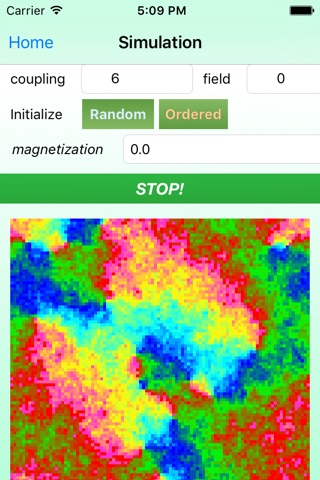
Physics to Go!
Part 2 - spin systems 2 to 4 dimensions
The app calculates an interacting system of spins (or magnets), including the well-known Ising model as well as more complex systems. You can choose the system size for up to 4 dimensions. The updating of the spins is done by a standard Monte-Carlo heatbath algorithm.
Various options for the spin-spin interaction are given. The coupling strength as well as a constant external field (acting in the vertical direction) can be specified.
The controls on the main page are:
system size: set the number of spins in 2 to 4 directions (for a 2-dim system set nz and nt to 1). The total number of spins in the system is nx*ny*nz*nt.
coupling: set the coupling strength between the spins (more accurately the coupling divided by the temperature). By changing the sign of the coupling the system tries to align spins in parallel (ferromagnetic) or anti-parallel (anti ferromagnetic direction.
# spins: you can set the number of possible spin directions. The choice of 2 corresponds to the Ising model (spin-up or spin-down). 4 means there are 4 possible directions (up, down, left, right) and so on.
field: set the strength of a constant field pointing into the vertical direction. The spins try to align in this direction.
plot cycles: you can determine after how many update cycles the new spin configurations is plotted on the screen.
You can choose to periodically change the coupling strength or the external field. Specify the amount of change and the frequency of the update. With this option you can study phase transitions from disordered to ordered (spin-aligned) states. You can observe different transition behavior depending on the number of dimensions or the type of interaction between the spins.
There are several possibilites of interactions between spins. The "nearest neighbour" choice corresponds to the Ising model- You can also add the interaction of the spins with the diagonally adjacent neighbours. For the other two choices the spins interact will all other spins in the system. The interaction strength falls off either like 1 over distance (Coulomb potential) or exp(-distance) over distance (Yukawa potential).
By choosing "ordered" or "random" you initialize the directions of the spins either as all aligned or randomly chosen.
Switching to the Graph View, following can be seen:
The averaged value of the spins (magnetization) and the standard deviation as well as the current value of the coupling and external field is shown.
Below the plotting frame shows the current spins. The direction of the spins is indicated by the direction of the symbols as well as the color (which is needed if you choose big systems, where the plotting area for a single spin is too small to show an arrow).
In the case of a 3 or 4 dimensional system only one 2-dimensional slice of the whole system is displayed.
Below this area the spin, averaged over the whole system is displayed, where the direction is given by the spin orientation and the size of the symbol represents the absolute value of the magnetization.
In the lower panel the current magnetization as well as the average value (averaged since the last change of the coupling or field) is shown.
You start the updating of the spins by touching "Plot" (interrupt the calculation at any time by touching the button again).
Enjoy the app!
